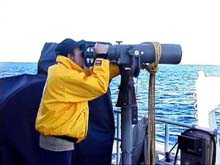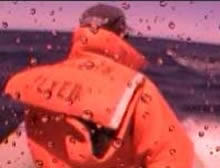
Scott Benson scans the horizon using the “bigeye” binoculars. These are so heavy that they must be mounted on a special stand that was bolted to the deck before leaving port. Click image for larger view.
Observations of
Surface-Dwelling Animals
May 22, 2002
Scott Benson, Marine Ecologist
National Marine Fisheries Service, NOAA
![]() Watch members of the science team when they encounter sperm whales. (mp4, 5.6 MB)
Watch members of the science team when they encounter sperm whales. (mp4, 5.6 MB)
As part of our exploration of Davidson Seamount, we will conduct visual observations using high-powered (25X150) binoculars, recording all marine mammals, seabirds, and sea turtles seen. Although our mission is to document all animal sightings, two species are of particular interest: the sperm whale and the leatherback sea turtle. Both are listed federally as Endangered Species. Although we don't yet know what our chances are of encountering either animal, both can potentially be found at the seamount, and we will attempt to obtain samples and information for each.
Sperm whales were historically subject to intensive whaling harvests throughout the North Pacific Ocean, with more than a quarter million animals taken during the 19th century. At present about 1,400 sperm whales are estimated to occur off the U.S. West coast, but their relationship to animals found farther offshore is poorly understood. As part of the ongoing efforts to monitor the status and recovery of sperm whales in the Eastern North Pacific, genetic studies of population structure are being conducted by the Southwest Fisheries Science Center (SWFSC). Preliminary analyses suggest that coastal California sperm whales are genetically distinct from the larger offshore population of sperm whales in the North Pacific. Results are confounded, however, by the large time period during which samples from different regions were collected – from the 70s to 90s – and the tendency of sperm whales to form tightly-structured family groups. For this reason, it is important to obtain additional, contemporary skin samples from sperm whales off California.
If we are lucky enough to encounter sperm whales during our cruise, we will try to obtain small skin samples to contribute to our understanding of population structure of this remarkable species.

The science party spots a sperm whale and rushes to get a closer observation. Watch a video account.
Click image to launch video. (QuickTime, 11Mb)
A small boat will be used to approach the whales, and a crossbow with specially designed arrows and biopsy tips will be used to obtain the skin samples. These samples will be returned to the SWFSC laboratory, where DNA will be extracted and sequenced for comparison with other individuals. These comparisons will allow us to determine how closely related individual sperm whales are and will help us to know whether they are indeed divided into two distinct and separate groups.
Sign up for the Ocean Explorer E-mail Update List.















